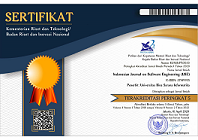Sentimen Analisis Terkait Lockdown pada Sosial Media Twitter
Abstract
Abstract: Covid-19 has been set as a Pandemic by the World Health Organization (WHO). The very large impact and the infection that is fast enough are the reasons for making Covid-19 as a pandemic and efforts to overcome. One anticipation that can be done is to do lockdown. Making the decision to carry out a lockdown is intended to reduce the spread that occurs. Lockdown is certainly not a 100% good solution for all of individual. There are individual who agree that the lockdown will be implemented, also there are those who think that the lockdown is better not to be carried out considering the negative impacts that can occur. Therefore in this study will be presented the predictive modeling for sentiment analysis related to "lockdown" specially on social media Twitter. The method used to labeled was using Vader then the tweets are extracted using TF-IDF, and modeling is made for the prediction of sentiment using Naïve Bayes and Support Vector Machine. The results obtained from the two algorithms are more than 80%.
Keywords: Covid-19, lockdown, TF-IDF, Naïve Bayes, Support Vector Machine
Abstrak: Covid-19 telah ditetapkan sebagia Pandemi oleh World Health Organization (WHO). Dampak yang sangat besar dan penyebaran yang cukup cepat menjadi alsan untuk menjadikan Covid-19 sebagai Pandemi dan perlu dilakukan upaya penanggulangan. Salah satu upaya yang bisa dilakukan adalah dengan melakukan lockdown. Pengambilan keputusan untuk melakukan lockdown diperuntukan guna mengurangi penyebaran yang terjadi. Lockdown tentunya bukanlah solusi yang 100% baik bagi segala pihak. Terdapat pihak - pihak yang menyetujui akan dilaksanakannya lockdown, ada pula yang beranggapan bahwa lockdown lebih baik tidak dilaksanakan dengan pertimbangan dampak negatif yang bisa terjadi. Oleh karena itu, pada penelitian ini akan disampaikan mengenai pembuatan pemodelan prediksi terkait analisa sentimen terkait “Lockdown” yang dikhususkan pada media sosial Twitter. Metode yang digunakan adalah dengan melakukan labeling menggunakan Vader dan selanjutnya tweet tersebut dilakukan ekstraksi menggunakan TF-IDF, dan dibuatkan pemodelan untuk prediksi sentimen menggunakan Naïve Bayes dan Support Vector Machine. Hasil evaluasi yang didapat dari kedua algoritma tersebut ialah mencapai lebih dari 80%.
Kata kunci: Covid-19, lockdown, TF-IDF, Naïve Bayes, Support Vector Machine
Abstract: Covid-19 has been set as a Pandemic by the World Health Organization (WHO). The very large impact and the infection that is fast enough are the reasons for making Covid-19 as a pandemic and efforts to overcome. One anticipation that can be done is to do lockdown. Making the decision to carry out a lockdown is intended to reduce the spread that occurs. Lockdown is certainly not a 100% good solution for all of individual. There are individual who agree that the lockdown will be implemented, also there are those who think that the lockdown is better not to be carried out considering the negative impacts that can occur. Therefore in this study will be presented the predictive modeling for sentiment analysis related to "lockdown" specially on social media Twitter. The method used to labeled was using Vader then the tweets are extracted using TF-IDF, and modeling is made for the prediction of sentiment using Naïve Bayes and Support Vector Machine. The results obtained from the two algorithms are more than 80%. Keywords:Covid-19, lockdown, TF-IDF, Naïve Bayes, Support Vector Machine
Abstrak: Covid-19 telah ditetapkan sebagia Pandemi oleh World Health Organization (WHO). Dampak yang sangat besar dan penyebaran yang cukup cepat menjadi alsan untuk menjadikan Covid-19 sebagai Pandemi dan perlu dilakukan upaya penanggulangan. Salah satu upaya yang bisa dilakukan adalah dengan melakukan lockdown. Pengambilan keputusan untuk melakukan lockdown diperuntukan guna mengurangi penyebaran yang terjadi. Lockdown tentunya bukanlah solusi yang 100% baik bagi segala pihak. Terdapat pihak - pihak yang menyetujui akan dilaksanakannya lockdown, ada pula yang beranggapan bahwa lockdown lebih baik tidak dilaksanakan dengan pertimbangan dampak negatif yang bisa terjadi. Oleh karena itu, pada penelitian ini akan disampaikan mengenai pembuatan pemodelan prediksi terkait analisa sentimen terkait “Lockdown” yang dikhususkan pada media sosial Twitter. Metode yang digunakan adalah dengan melakukan labeling menggunakan Vader dan selanjutnya tweet tersebut dilakukan ekstraksi menggunakan TF-IDF, dan dibuatkan pemodelan untuk prediksi sentimen menggunakan Naïve Bayes dan Support Vector Machine. Hasil evaluasi yang didapat dari kedua algoritma tersebut ialah mencapai lebih dari 80%.
Kata kunci: Covid-19, lockdown, TF-IDF, Naïve Bayes, Support Vector Machine
Full Text:
PDFReferences
Azevedo, A., & Santos, M. F. (2008). KDD, semma and CRISP-DM: A parallel overview. MCCSIS’08 - IADIS Multi Conference on Computer Science and Information Systems; Proceedings of Informatics 2008 and Data Mining 2008.
Buntoro, G. A., Alvianda, F., Adikara, P. P., Al Kabir, A. H., Yasid, M., Hayuningtyas, R. Y., … Susanto, A. (2019). Analisis Sentimen Opini Publik Bahasa Indonesia Terhadap Wisata Tmii Menggunakan Naïve Bayes Dan Pso. Jurnal Pengembangan Teknologi Informasi Dan Ilmu Komputer (J-PTIIK) Universitas Brawijaya, 3(1), 1–10. https://doi.org/10.22219/repositor.v1i1.11
Bustami. (2014). Penerapan Algoritma Naive Bayes. Jurnal Informatika.
Cucinotta, D., & Vanelli, M. (2020). WHO declares COVID-19 a pandemic. Acta Biomedica. https://doi.org/10.23750/abm.v91i1.9397
Frank, E., Trigg, L., Holmes, G., & Witten, I. H. (2000). Naive Bayes for Regression. Machine Learning, 41(1), 5–25. Retrieved from http://www.cs.waikato.ac.nz/~eibe/pubs/nbr.pdf
Lau, H., Khosrawipour, V., Kocbach, P., Mikolajczyk, A., Schubert, J., Bania, J., & Khosrawipour, T. (2020). The positive impact of lockdown in Wuhan on containing the COVID-19 outbreak in China. Journal of Travel Medicine. https://doi.org/10.1093/jtm/taaa037
Ma, Y., & Guo, G. (2014). Support vector machines applications. In Support Vector Machines Applications. https://doi.org/10.1007/978-3-319-02300-7
Pramono, F., Didi Rosiyadi, & Windu Gata. (2019). Integrasi N-gram, Information Gain, Particle Swarm Optimation di Naïve Bayes untuk Optimasi Sentimen Google Classroom. Jurnal RESTI (Rekayasa Sistem Dan Teknologi Informasi), 3(3), 383–388. https://doi.org/10.29207/resti.v3i3.1119
Pratama, B. Y., & Sarno, R. (2016). Personality classification based on Twitter text using Naive Bayes, KNN and SVM. Proceedings of 2015 International Conference on Data and Software Engineering, ICODSE 2015. https://doi.org/10.1109/ICODSE.2015.7436992
Text Mining Dan Sentimen Analisis Twitter Pada Gerakan Lgbt. (2017). Intuisi : Jurnal Psikologi Ilmiah, 9(1), 18–25.
Wardhani, P. A. (2015). Business Intelligence, Analytics, and Data Science: A Managerial Perspective. In Efikasi Diri dan Pemahaman Konsep IPA dengan Hasil Belajar Ilmu Pengetahuan Alam Siswa Sekolah Dasar Negeri Kota Bengkulu (4th ed., Vol. 6). https://doi.org/10.1017/CBO9781107415324.004
DOI: https://doi.org/10.31294/ijse.v6i2.8991

This work is licensed under a Creative Commons Attribution-NonCommercial-ShareAlike 4.0 International License.
ISSN : 2714-9935


Published by LPPM Universitas Bina Sarana Informatika
Jl. Kramat Raya No.98, Kwitang, Kec. Senen, Kota Jakarta Pusat, DKI Jakarta 10450
This work is licensed under a Creative Commons Attribution-ShareAlike 4.0 International License










